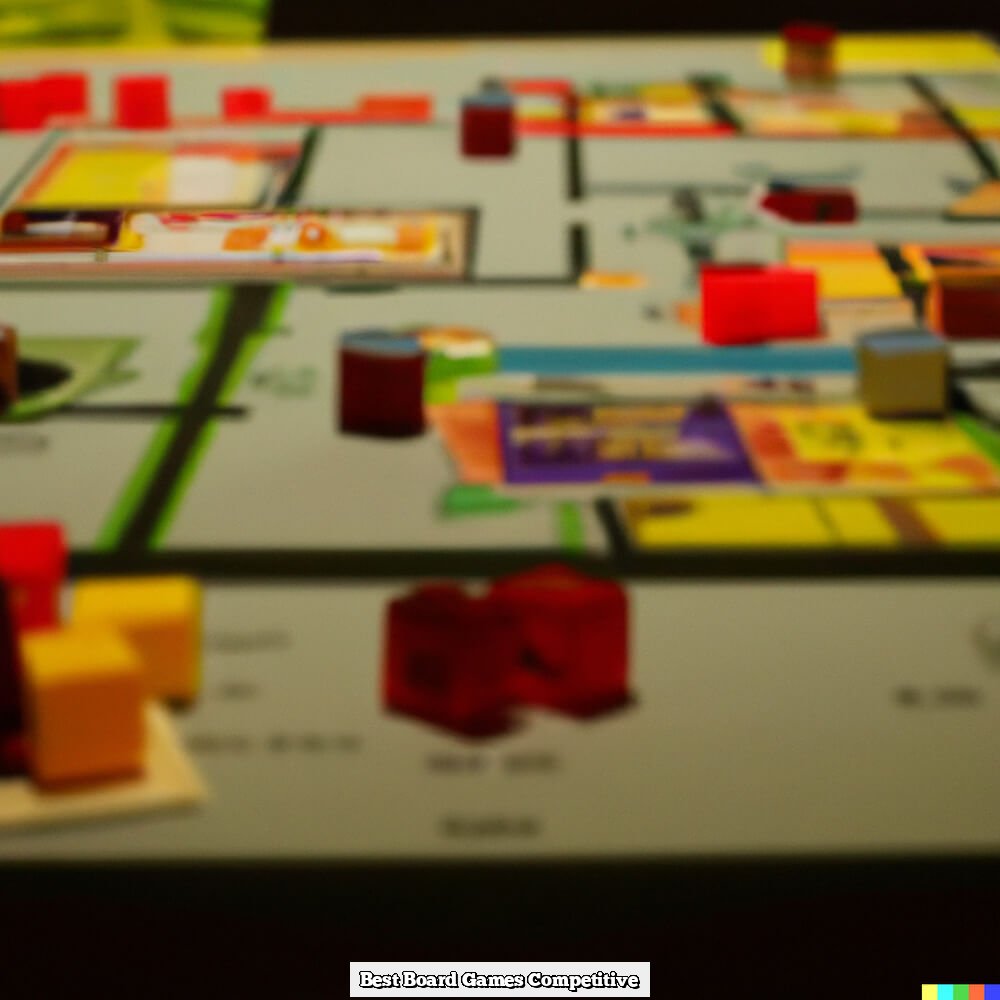Competitive board games strategy is a crucial aspect that can make or break your gameplay experience. Whether you’re a seasoned player or just starting, understanding the ins and outs of strategic thinking in board games is key to achieving victory. In this article, we delve into the world of competitive board games strategy, exploring its importance, different types of strategies used, analyzing player tactics, and providing tips for developing your own winning strategy.
In competitive board games, strategy plays a pivotal role in determining the outcome of the game. From resource management to tactical maneuvers, every decision you make can have a significant impact on your chances of success. The ability to think strategically and anticipate your opponents’ moves is what sets apart the winners from the losers in these games. By mastering various strategies and adapting them to different game scenarios, players can increase their chances of coming out on top.
Whether you enjoy complex strategy games like Settlers of Catan or fast-paced card games like Poker, each type of competitive board game requires a unique approach to strategic gameplay. Understanding the nuances of each game’s mechanics and objectives is essential for formulating an effective strategy that will lead you to victory.
As we explore different player strategies in board games and analyze popular competitive titles, you’ll gain insights into how strategic thinking can elevate your gaming experience to new heights.
Importance of Strategy in Competitive Board Games
Strategy plays a vital role in competitive board games, as it is the key factor that can determine the outcome of a game. Without a well-thought-out strategy, players may find themselves at a significant disadvantage against their opponents. Whether it’s planning ahead, outmaneuvering other players, or adapting to changing circumstances during gameplay, having a strong strategy can make all the difference in emerging victorious in competitive board games.
One of the main reasons why strategy is crucial in competitive board games is because it allows players to anticipate their opponents’ moves and counter them effectively. By analyzing the game state and predicting what their rivals might do next, players can come up with strategic moves to gain an advantage or disrupt their opponents’ plans.
This element of strategic thinking adds depth and complexity to board games, making them more engaging and challenging for players looking to test their skills.
Moreover, having a solid strategy in competitive board games not only enhances your chances of winning but also adds an extra layer of excitement to the gameplay. The thrill of outsmarting your opponents through clever tactics and strategic maneuvers can be incredibly satisfying.
It also encourages players to think critically, analyze different options, and make calculated decisions – skills that are not only valuable in board games but also applicable in various real-life scenarios. Overall, strategy is essential for maximizing your performance and enjoyment in competitive board games.
Types of Competitive Board Games and Their Strategy
When it comes to competitive board games, there is a wide range of options that cater to different preferences and gameplay styles. Some popular types of competitive board games include strategy-driven games, social deduction games, area control games, deck-building games, and many more. Each type of game requires a unique approach and understanding of the mechanics to develop a winning strategy.
In strategy-driven board games, such as “Settlers of Catan” or “Ticket to Ride,” players must carefully plan their moves to outsmart their opponents and secure victory points. These games often involve resource management, long-term planning, and adapting to changing game conditions. On the other hand, social deduction games like “Werewolf” or “Secret Hitler” require players to bluff, mislead, and deduce the true intentions of others to come out on top.
Deck-building games like “Dominion” or “Star Realms” challenge players to build efficient decks of cards while competing with opponents for limited resources and strategic advantages. Area control games such as “Risk” or “Game of Thrones: The Board Game” test players’ ability to expand their influence while defending against rivals. By understanding the dynamics and objectives of each type of competitive board game, players can tailor their strategies for optimal performance.
In addition to understanding the specific strategies needed for each type of competitive board game, players should also consider their own strengths and weaknesses when developing a gameplay strategy. Some individuals may excel at long-term planning and resource management, while others may thrive in high-pressure situations that require quick thinking and adaptability. By recognizing and honing their natural abilities, players can improve their overall performance in competitive board games.
| Types | Examples |
|---|---|
| Strategy-Driven Games | “Settlers of Catan”, “Ticket to Ride” |
| Social Deduction Games | “Werewolf”, “Secret Hitler” |
| Deck-Building Games | “Dominion”, “Star Realms” |
Analyzing Different Player Strategies in Board Games
When it comes to competitive board games, understanding the different player strategies can be a key factor in achieving victory. Each player brings their own unique approach to the game, making it essential to analyze and adapt to their tactics. By studying the various strategies employed by different players, you can enhance your own gameplay and increase your chances of success.
Aggressive Players
One common strategy seen in competitive board games is aggressive play. Aggressive players are focused on gaining advantages early in the game by taking risks and making bold moves. These players are not afraid to confront opponents directly, often engaging in direct conflict to secure control of resources or territories. While this strategy can yield quick results, aggressive players must be careful not to overextend themselves and become vulnerable to counterattacks.
Defensive Players
On the other end of the spectrum are defensive players who prioritize protecting their assets and maintaining a strong defense. These players tend to build up their positions gradually, focusing on securing key areas of the board and establishing strong defensive lines. Defensive players excel at outlasting opponents and capitalizing on mistakes made by more aggressive players. However, they must be cautious not to fall behind in terms of resource accumulation or strategic opportunities.
Adaptive Players
Adaptive players are those who possess the ability to switch between different strategies based on evolving circumstances throughout the game. These players are versatile and capable of adjusting their gameplay style on the fly, depending on factors such as opponent actions, changing objectives, or unexpected events. Adaptive players have a knack for staying ahead of the curve and capitalizing on emerging opportunities quickly. Mastering this type of flexibility can provide a significant advantage in competitive board games strategy.
By analyzing and understanding the various player strategies in board games, you can sharpen your own strategic acumen and improve your overall performance at the gaming table. Whether you prefer aggressive tactics, defensive maneuvers, or adaptable gameplay, being aware of different approaches will allow you to anticipate your opponents’ moves and make informed decisions that lead to victory.
Remember that each player brings a unique perspective to the game – harnessing this knowledge can elevate your competitive edge and bring you closer to mastering strategic gameplay in board games.keyword: competitive board games strategy.
Tips for Developing Your Own Board Game Strategy
Developing your own board game strategy is a crucial aspect of mastering competitive board games. It requires a combination of critical thinking, adaptability, and foresight to outmaneuver your opponents. Here are some tips to help you enhance your strategic gameplay:
Know Your Game
Before jumping into a competitive board game, take the time to thoroughly understand the rules, objectives, and mechanics of the game. Familiarize yourself with different strategies that players commonly use and analyze how they contribute to winning outcomes.
Observe Your Opponents
Pay close attention to how your opponents are playing the game. Look for patterns in their moves, anticipate their next steps, and adjust your strategy accordingly. By understanding their tactics, you can develop counter-strategies to gain an advantage during gameplay.
Practice and Experiment
The old adage “practice makes perfect” holds true for competitive board games strategy as well. Allocate time to practice different strategies in solo games or with friends to test their effectiveness. Don’t be afraid to experiment with new approaches and tactics; this will broaden your strategic repertoire and make you a more versatile player.
By following these tips and continuously honing your skills in competitive board games strategy, you’ll be better equipped to face various challenges and emerge victorious in intense gaming sessions. Remember that strategic thinking is not only about making calculated decisions but also about adapting on-the-fly based on changing circumstances – a skill that sets master strategists apart from casual players in the world of competitive board gaming.
Strategic Thinking vs Tactical Thinking in Board Games
When it comes to competitive board games strategy, understanding the difference between strategic thinking and tactical thinking is essential. Strategic thinking involves planning for the long term, considering the overall goal of the game and how to achieve it. On the other hand, tactical thinking focuses on making short-term decisions based on the current game state and immediate opportunities.
In many board games, players must balance both strategic and tactical thinking to be successful. Here are some key differences between the two approaches:
- Strategic Thinking: Involves considering future moves, anticipating opponents’ actions, and setting long-term goals.
- Tactical Thinking: Involves reacting to the current board state, maximizing immediate benefits, and adjusting plans based on short-term developments.
Being able to switch between strategic and tactical thinking depending on the game situation is a crucial skill in competitive board games strategy. Mastering this balance can give players a significant edge over their opponents.
Furthermore, some board games may favor one type of thinking over the other. For example, a game that requires careful planning and resource management may lean more towards strategic thinking, while a fast-paced game with constantly changing dynamics may require more focus on tactical decisions. Understanding which type of thinking is most effective in each game can greatly impact your success as a player in competitive board games strategy.
Common Mistakes in Competitive Board Games Strategy
When engaging in competitive board games, it is crucial to have a solid strategy in place to increase your chances of winning. However, there are common mistakes that many players make which can ultimately hinder their performance. One of the most prevalent errors is failing to adapt to the changing dynamics of the game. Players who stick rigidly to their initial strategy without considering the moves of their opponents often find themselves at a disadvantage.
Another mistake often seen in competitive board games is overextending oneself. This means spreading resources too thin or taking on more than one can handle, leading to a weakened position on the board. It is essential to strike a balance between aggression and defense, ensuring that you are not left vulnerable while also making strategic advancements towards victory.
Furthermore, underestimating the importance of timing in competitive board games strategy can be detrimental. Knowing when to make bold moves or when to bide your time is key to success. Players who act too hastily or wait too long before taking action may miss out on critical opportunities to gain an advantage over their opponents.
| Common Mistakes | Impact |
|---|---|
| Failing to Adapt | Disadvantage against opponents |
| Overextending Resources | Weakened position on the board |
| Underestimating Timing | Missed opportunities for strategic advantage |
Game Analysis
When it comes to competitive board games, having a solid strategy can make all the difference between winning and losing. Each popular board game has its own unique set of rules, mechanics, and objectives that require different approaches to succeed. Here are some insights into the strategies of well-known competitive board games:
1. Chess: In the world of competitive board games, Chess is often seen as the ultimate test of strategic thinking. Players must anticipate their opponent’s moves while planning their own in advance. It is crucial to control the center of the board, develop pieces efficiently, and maintain a strong defense to outsmart your opponent.
2. Settlers of Catan: Settlers of Catan is a popular strategy board game that involves resource management and negotiation skills. Players must strategically place settlements and cities to maximize resource production while trying to block their opponents from expanding. Trading with other players can also be a key tactic in gaining the resources needed for victory.
3. Ticket to Ride: In Ticket to Ride, players compete to build railway routes across North America or other regions on the map. Strategic planning is essential in completing destination tickets efficiently while blocking opponents’ paths and securing critical routes for yourself. Balancing long-term goals with short-term objectives is key to success in this game.
By understanding the specific strategies required for different popular competitive board games like Chess, Settlers of Catan, and Ticket to Ride, players can enhance their gameplay and increase their chances of winning. Whether it’s through careful planning, resource management, or tactical positioning, mastering these strategies can lead to competitive success in the world of board gaming.
Conclusion
In conclusion, mastering strategic gameplay in competitive board games is essential for success in this challenging and engaging recreational activity. Strategy plays a crucial role in determining the outcome of these games, requiring players to think critically, plan ahead, and adapt to changing circumstances. By understanding the importance of strategy and honing your strategic skills, you can increase your chances of victory and enjoy a more fulfilling gaming experience.
Whether you prefer classic games like chess or modern favorites like Settlers of Catan, developing a solid competitive board game strategy is key to achieving your goals. Take the time to analyze different player strategies, learn from their approaches, and incorporate successful tactics into your own gameplay. Experiment with different strategies, adapt based on the specific game dynamics, and continuously improve your skills to stay ahead of the competition.
In the world of competitive board games strategy, there is always room for growth and learning. Keep challenging yourself, seek out new opportunities to test your strategic thinking abilities, and never be afraid to try new tactics.
By embracing strategic gameplay as a central aspect of your gaming experience, you can enhance your enjoyment of board games while sharpening your critical thinking skills. So gather your friends or family for a game night, put your strategic prowess to the test, and embark on an exciting journey towards becoming a master strategist in competitive board games.
Frequently Asked Questions
What Is the Most Strategic Board Game?
The most strategic board game is often considered to be chess. Chess requires players to think several moves ahead, anticipate their opponent’s actions, and strategically position their pieces on the board to achieve victory.
What Makes a Board Game Strategic?
What makes a board game strategic is the level of decision-making involved in playing it. Strategic board games typically require players to consider various options, predict possible outcomes, and adapt their strategies based on changing circumstances throughout the game.
Is There a Board Game Called Strategy?
While there isn’t a specific board game called “Strategy,” many board games incorporate strategic elements into their gameplay. Games like Risk, Settlers of Catan, and Terra Mystica are examples of board games that heavily rely on strategic thinking to outsmart opponents and achieve victory.

I love playing all kinds of games – from classics like Monopoly to modern favourites like Ticket to Ride.
I created this blog as a way to share my love of board games with others, and provide information on the latest releases and news in the industry.





